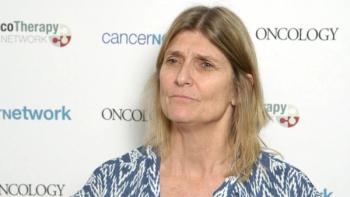
In this interview we discuss clinical developments in essential thrombocythemia, polycythemia vera, and myelofibrosis, as well as the latest treatment options.

Your AI-Trained Oncology Knowledge Connection!


In this interview we discuss clinical developments in essential thrombocythemia, polycythemia vera, and myelofibrosis, as well as the latest treatment options.

New treatment options are now available for light-chain amyloidosis, with additional ones on the way, according to a presentation at the 21st Annual International Congress on Hematologic Malignancies.

Adolescents and young adults with leukemia experienced inferior outcomes compared with children, especially if they were treated outside of a specialized cancer center.

Patients with chronic lymphocytic leukemia who discontinue treatment with ibrutinib due to disease progression or transformation had significantly worse survival compared with patients who discontinued therapy because of intolerance.

A 60-year-old man with a history of coronary artery disease and JAK2 V617F–positive polycythemia vera presented to our bone marrow transplantation clinic with progressive fatigue, splenomegaly, and cytopenias.

This article reviews newly approved drugs for hematologic malignancies: their indications, mechanisms of action, accompanying pivotal trial data, pertinent toxicities, use in special populations, and appropriate clinical context.

Genetic profiling combined with clinical factors may help guide clinicians on how to better manage patients with myelodysplastic syndrome.

There was no association between conventional response outcomes, such as complete response or very good partial response, and survival in patients with newly diagnosed multiple myeloma.

Despite significant toxicities, idelalisib improved time to progression for patients with treatment-resistant chronic lymphocytic leukemia.

Upfront treatment with melphalan and ASCT should be the standard treatment approach for younger patients with newly diagnosed multiple myeloma.

The use of the thrombopoietin receptor agonist eltrombopag was clinically effective at raising platelet counts in patients with lower-risk myelodysplastic syndromes with severe thrombocytopenia.

Combined miniCHOP and treatment with the fully-human anti-CD20 monoclonal antibody ofatumumab is associated with improved overall survival among elderly patients diagnosed with diffuse large B-cell lymphoma.

Stem cells that give rise to acute myeloid leukemia (AML) and myelodysplastic syndrome (MDS) express higher levels of the CD99 cell surface protein-sugar molecule than normal stem cells.

This video examines the evolution in treatment and survival outcomes for patients with follicular lymphoma and highlights trials testing newer agents such as immunotherapies in this population.

The FDA recently approved the oral BTK inhibitor ibrutinib for the treatment of patients with relapsed or refractory marginal zone lymphoma who require systemic therapy and have had at least one prior anti-CD20 therapy.

CML patients who have high expression of the T-cell inhibitory receptor (CTLA-4)-ligand CD86 on plasmacytoid dendritic cells have a higher risk of relapsing after discontinuing therapy with a tyrosine kinase inhibitor.

This video examines a phase I/II study of ibrutinib in patients with chronic GVHD who failed corticosteroids.

Adding bortezomib to lenalidomide and dexamethasone improved progression-free and overall survival in patients with newly diagnosed multiple myeloma who were not planned for immediate stem-cell transplant.

One of the confounding issues with treating patients with immunotherapy for hematologic diseases is the risk of relapse that can occur during and after treatment.

The combination of bortezomib and dexamethasone with 160 mg daily ricolinostat, a selective histone deacetylase 6 inhibitor, was well tolerated and active in patients with relapsed/refractory multiple myeloma.

The addition of clofarabine to standard induction therapy for newly diagnosed acute myeloblastic leukemia reduced the probably of relapse but increased toxicity and had no effect on survival.

Here we critically analyze the role of PET/CT in the early assessment of Hodgkin lymphoma.

Here we review the role of interim PET/CT in diffuse large B-cell lymphoma (DLBCL), and also explore the question of whether new approaches to quantitative assessment improve the prognostic value of interim PET scans in both Hodgkin lymphoma and DLBCL.

Here we outline the most promising novel cellular immune strategies for patients with multiple myeloma. In addition, we highlight combinatorial approaches that, it is hoped, will further optimize cellular immunotherapies for myeloma and lead to deep and durable responses and, possibly, even cures.

Unfortunately, while survival outcomes with novel therapies have improved, the fraction of patients with multiple myeloma who are cured of their disease remains low. Immune therapies offer the hope for further improvement in outcomes and higher rates of cure.